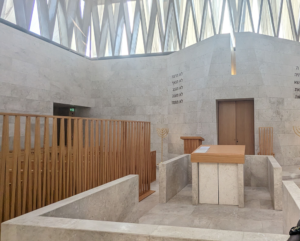By Ebenezer Chike Adjei NJOKU
No longer shall you be named Abram,
But your name shall be Abraham;
For I have made you the father of a multitude of nations
(Gen 17:5)
With over 4.3 billion adherents, followers of the Abrahamic religions – (Christians: 2.38 billion, Muslims: 1.9 billion and Jews: 15 million) – make up approximately 61 percent of the global population. They cut across diverse contexts across the globe.
While they have a lot in common, for over 1,500 years, unease has characterised their interactions as a result of their points of divergence; and this has been greatly amplified in different media with different agenda. This has led to questions over the possibility of peaceful co-existence on an enduring basis. Yet, in the heart of the gulf, in Abu Dhabi’s Saadiyat Cultural District, lies a microcosm of what is possible.

The Abrahamic Family House
Within the Saadiyat Cultural District lies the Abrahamic Family House, a powerful symbol of unity in diversity. This complex brings together three houses of worship – a mosque, a church and a synagogue – representing the Abrahamic faiths. This historic idea was borne out of the desire to ensure peaceful coexistence among the diverse people who live and work in Abu Dhabi.
The project reflects the UAE’s long history of peaceful coexistence between people of various backgrounds. Archaeological discoveries, like the seventh-century Christian monastery on Sir Bani Yas Island, highlight this rich heritage. It should come as no surprise that the Emirates, which was historically a convergence point for different cultures and people, today has more than 180 unique nationalities living within its borders.
Designed for unity
The renowned architectural firm Adjaye Associates designed the Abrahamic Family House to foster interaction and connection. The three buildings are constructed with equal stature, size and materials, eliminating any sense of superiority. They share a landscaped garden, creating a common space for gatherings and fostering a sense of community.
While each house of worship reflects the unique traditions of its faith, they are designed in harmony with one another. The mosque, named after the Grand Imam of Al-Azhar Ahmed El-Tayeb, features seven arches, a significant number in Islam. Its interior boasts nine ascending vaults, culminating in elegant sail vaults. The intricate mashrabiya latticework provides a sense of privacy while maintaining a connection with the surroundings.
The church, dedicated to St. Francis of Assisi, embodies the concept of light, a symbol of divinity in Christianity. The St. Francis Church is bathed in natural light filtering through the structure. Its forest of columns maximises eastern light and symbolises both incarnation and resurrection, central Christian themes. The timber battens evoke rays of light and reference the St. Peter’s Basilica altar.
The synagogue, named after Moses Ben Maimon, a revered Jewish philosopher, evokes a traditional place of prayer. Its exterior features a crisscross pattern reminiscent of palm fronds used to build a Sukkah, a temporary structure symbolising shelter during the Festival of Sukkot. The bronze chainmail reflects the tent-like structure of the Sukkah, while the skylight references a chuppah, a canopy used during Jewish weddings.

A symbol of hope
In the words of His Excellency Al Mubarak, the Chairman of the Department of Culture and Tourism Abu Dhabi (DCT Abu Dhabi): “At the Abrahamic Family House, there is a remarkable atmosphere of coexistence. On Fridays, residents and schoolchildren hear the Muslim call to prayer and the Friday sermon.
“On Sundays, they hear the church bells for Sunday mass. During Yom Kippur, they hear the Jewish horn; and on Shabbat, they see the Jewish community gathering to pray in the synagogue. This daily interaction with different faiths eliminates many biases because people are no longer seeing differences but rather commonalities. They witness individuals in their human form, practising their beliefs harmoniously.”
The Abrahamic Family House stands as a powerful symbol meant to have influence beyond the Saadiyat Cultural District. It is evidence of the possibility of peaceful coexistence and interfaith understanding. It serves as an inspiration for communities around the world, demonstrating how shared heritage can bridge differences and foster a future built on mutual respect and cooperation.










